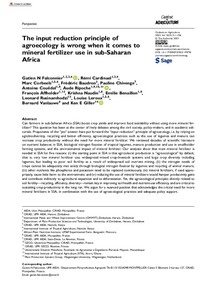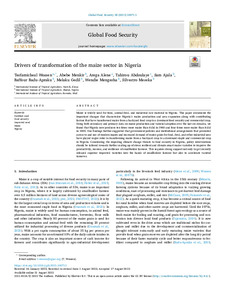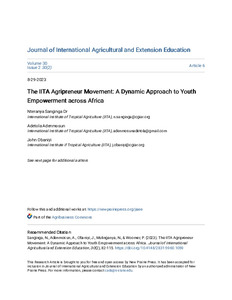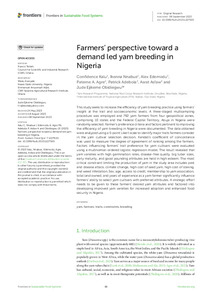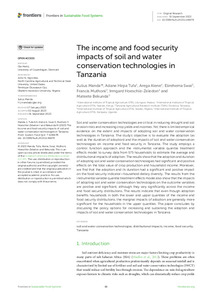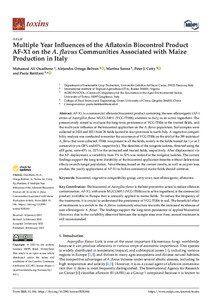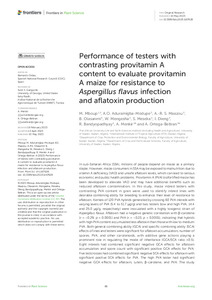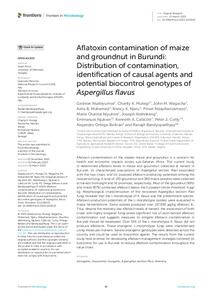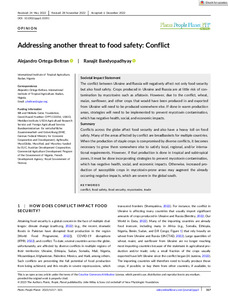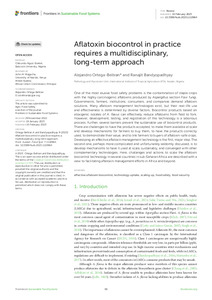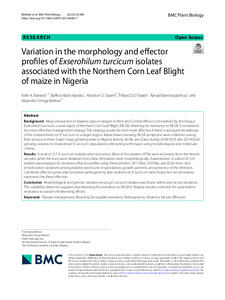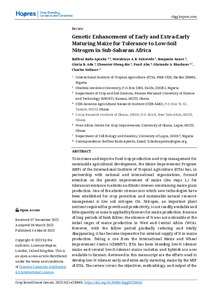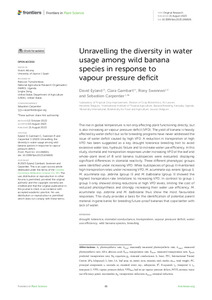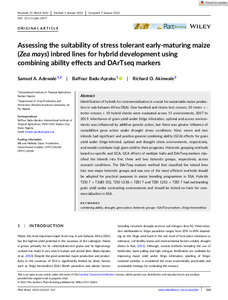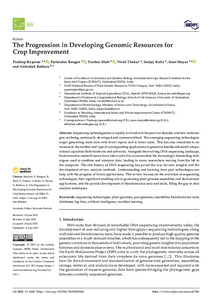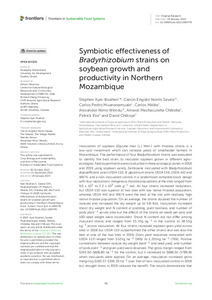Welcome to the International Institute of Tropical Agriculture Research Repository
IITA Bibliography System: Recent submissions
Now showing items 361-380 of 8094
-
The input reduction principle of agroecology is wrong when it comes to mineral fertilizer use in sub-Saharan Africa
(2023-09)Can farmers in sub-Saharan Africa (SSA) boost crop yields and improve food availability without using more mineral fertilizer? This question has been at the center of lively debates among the civil society, policy-makers, and in academic editorials. Proponents of the “yes” answer have put forward the “input reduction” principle of agroecology, i.e. by relying on agrobiodiversity, recycling and better efficiency, agroecological practices such as the use of legumes and manure can increase crop ... -
Assessing the impact of Gliricidia agroforestry-based interventions on crop nutritional, antinutritional, functional, and mineral compositions in eastern Province, Zambia
(2023-09-10)Agroforestry practices improve soil health which in turn improves crop nutrient concentrations and quality. This study examined how the agroforestry tree Gliricidia sepium intercropped with soybean, groundnuts, or maize affects crop nutrient compositions. The study was conducted in five Zambian chiefdoms for three crop-growing seasons (2019–2022) on 13 farmer-led demonstration trial sites. Seven treatments were tested that included maize, soybean, and groundnut plots with and without Gliricidia ... -
Drivers of transformation of the maize sector in Nigeria
(2023-09)Maize is widely used for food, animal feed, and industrial raw material in Nigeria. This paper documents the important changes that characterize Nigeria’s maize production and area expansion along with contributing factors that have transformed maize from a backyard food crop to a dominant food security and commercial crop. Using both secondary and primary data on maize production and varietal adoption over the last six decades, we found that Nigeria now produces ten times more maize than it did ... -
The IITA agripreneur movement: a dynamic approach to youth empowerment across Africa
(2023-08-29)The Agripreneur Movement of the International Institute of Tropical Agriculture (IITA) allows youth to assume their rightful place in African agricultural transformation. It started as a single exploratory agribusiness incubation at IITA Headquarters in 2012, involving 37 youths. It has since grown to 10 countries through nine sponsoring organizations. We compiled the characteristics and outcomes of 40 Agripreneur projects between 2012 and 2021 to describe the movement’s growth. With time, the ... -
Farmers’ perspective toward a demand led yam breeding in Nigeria
(2023-09-08)This study seeks to increase the efficiency of yam breeding practice using farmers’ insight at the trait and socioeconomic levels. A three-staged multisampling procedure was employed and 792 yam farmers from four geopolitical zones, comprising 10 states and the Federal Capital Territory, Abuja in Nigeria were randomly selected. Farmer’s preference criteria and factors pertinent to improving the efficiency of yam breeding in Nigeria were documented. The data obtained were analyzed using a 5-point ... -
The income and food security impacts of soil and water conservation technologies in Tanzania
(2023-09-01)Soil and water conservation technologies are critical in reducing drought and soil erosion risks and increasing crop yields and incomes. Yet, there is limited empirical evidence on the extent and impacts of adopting soil and water conservation technologies in Tanzania. The study’s objective is to evaluate the adoption (as well as the duration of adoption) and the impacts of soil and water conservation technologies on income and food security in Tanzania. The study employs a control function approach ... -
Multiple year influences of the aflatoxin biocontrol product AF-X1 on the A. flavus communities associated with maize production in Italy
(2023-02-28)AF-X1 is a commercial aflatoxin biocontrol product containing the non-aflatoxigenic (AF-) strain of Aspergillus flavus MUCL54911 (VCG IT006), endemic to Italy, as an active ingredient. The present study aimed to evaluate the long-term persistence of VCG IT006 in the treated fields, and the multi-year influence of the biocontrol application on the A. flavus population. Soil samples were collected in 2020 and 2021 from 28 fields located in four provinces in north Italy. A vegetative compatibility ... -
Uneven ground? Intersectional gender inequalities in the commercialized cassava seed system in Tanzania
(2023-10-02)Cassava (Manihot esculenta Crantz) is an important crop in Africa, especially to women who rely on it as a household staple food and source of income. In Tanzania, a recent move toward commercializing the cassava seed system resulted in significantly fewer women than men farmers, known as Cassava Seed Entrepreneurs (CSEs), producing improved seed for sale to fellow farmers. To document the barriers and constraints that create gender inequalities in the seed system to better understand women’s low ... -
Performance of testers with contrasting provitamin A content to evaluate provitamin A maize for resistance to Aspergillus flavus infection and aflatoxin production
(2023-05-10)In sub-Saharan Africa (SSA), millions of people depend on maize as a primary staple. However, maize consumers in SSA may be exposed to malnutrition due to vitamin A deficiency (VAD) and unsafe aflatoxin levels, which can lead to serious economic and public health problems. Provitamin A (PVA) biofortified maize has been developed to alleviate VAD and may have additional benefits such as reduced aflatoxin contamination. In this study, maize inbred testers with contrasting PVA content in grain were ... -
flatoxin contamination of maize and groundnut in Burundi: distribution of contamination, identification of causal agents and potential biocontrol genotypes of Aspergillus flavus
(2023-03-13)Aflatoxin contamination of the staples maize and groundnut is a concern for health and economic impacts across sub-Saharan Africa. The current study (i) determined aflatoxin levels in maize and groundnut collected at harvest in Burundi, (ii) characterized populations of Aspergillus section Flavi associated with the two crops, and (iii) assessed aflatoxin-producing potentials among the recovered fungi. A total of 120 groundnut and 380 maize samples were collected at harvest from eight and 16 ... -
Addressing another threat to food safety: conflict
(2023-01-14)Societal Impact Statement The conflict between Ukraine and Russia will negatively affect not only food security but also food safety. Crops produced in Ukraine and Russia are at little risk of contamination by mycotoxins such as aflatoxin. However, due to the conflict, wheat, maize, sunflower, and other crops that would have been produced in and exported from Ukraine will need to be produced somewhere else. If done in warm production areas, strategies will need to be implemented to prevent mycotoxin ... -
Aflatoxin biocontrol in practice requires a multidisciplinary, long-term approach
(2023-02-10)One of the most elusive food safety problems is the contamination of staple crops with the highly carcinogenic aflatoxins produced by Aspergillus section Flavi fungi. Governments, farmers, institutions, consumers, and companies demand aflatoxin solutions. Many aflatoxin management technologies exist, but their real-life use and effectiveness is determined by diverse factors. Biocontrol products based on atoxigenic isolates of A. flavus can effectively reduce aflatoxins from field to fork. However, ... -
Variation in the morphology and effector profiles of Exserohilum turcicum isolates associated with the Northern Corn Leaf Blight of maize in Nigeria
(2023-08-10)Background Maize production in lowland agro-ecologies in West and Central Africa is constrained by the fungus Exserohilum turcicum, causal agent of Northern Corn Leaf Blight (NCLB). Breeding for resistance to NCLB is considered the most effective management strategy. The strategy would be even more effective if there is adequate knowledge of the characteristics of E. turcicum in a target region. Maize leaves showing NCLB symptoms were collected during field surveys in three major maize growing ... -
The fate of nitrogen during agricultural intensification in East Africa: nitrogen budgets in contrasting agroecosystems
(2023-07-09)The intensification of agricultural systems in sub-Saharan Africa (SSA) is necessary to reduce poverty and improve food security, but increased nutrient applications in smallholder systems could have negative consequences for water quality, greenhouse gas emissions, and air quality. We tracked nitrogen (N) inputs and measured maize (Zea mays) biomass, grain yields, N leaching, and nitric oxide (NO) and nitrous oxide fluxes from a clayey soil in Yala, Kenya and a sandy soil in Tumbi, Tanzania, with ... -
Genetic enhancement of early and extra-early maturing maize for tolerance to low-soil nitrogen in sub-Saharan Africa
(2023-03-14)To increase and improve food crop production and crop management for sustainable agricultural development, the Maize Improvement Program (MIP) of the International Institute of Tropical Agriculture (IITA) has, in partnership with national and international organizations, focused attention on the genetic improvement of maize (Zea mays L.) for tolerance/resistance to abiotic and biotic stresses constraining maize grain production. One of the abiotic stresses into which new technologies have been ... -
Unravelling the diversity in water usage among wild banana species in response to vapour pressure deficit
(2023-08-21)The rise in global temperature is not only affecting plant functioning directly, but is also increasing air vapour pressure deficit (VPD). The yield of banana is heavily affected by water deficit but so far breeding programs have never addressed the issue of water deficit caused by high VPD. A reduction in transpiration at high VPD has been suggested as a key drought tolerance breeding trait to avoid excessive water loss, hydraulic failure and to increase water use efficiency. In this study, ... -
Assessing the suitability of stress tolerant early-maturing maize (Zea mays) inbred lines for hybrid development using combining ability effects and DArTseq markers
(2023-04)Identification of hybrids for commercialization is crucial for sustainable maize production in sub-Saharan Africa (SSA). One hundred and ninety test crosses, 10 tester × tester crosses + 10 hybrid checks were evaluated across 11 environments, 2017 to 2019. Inheritance of grain yield under Striga infestation, optimal and across environments was influenced by additive genetic action, but there was greater influence of nonadditive gene action under drought stress conditions. Nine, seven and two inbreds ... -
The progression in developing genomic resources for crop improvement
(2023-07-31)Sequencing technologies have rapidly evolved over the past two decades, and new technologies are being continually developed and commercialized. The emerging sequencing technologies target generating more data with fewer inputs and at lower costs. This has also translated to an increase in the number and type of corresponding applications in genomics besides enhanced computational capacities (both hardware and software). Alongside the evolving DNA sequencing landscape, bioinformatics research teams ... -
Combined effects of shade and drought on physiology, growth, and yield of mature cocoa trees
(2023-11)Climate models predict decreasing precipitation and increasing air temperature, causing concern for the future of cocoa in the major producing regions worldwide. It has been suggested that shade could alleviate stress by reducing radiation intensity and conserving soil moisture, but few on-farm cocoa studies are testing this hypothesis. Here, for 33 months, we subjected twelve-year cocoa plants in Ghana to three levels of rainwater suppression (full rainwater, 1/3 rainwater suppression and 2/3 ... -
Symbiotic effectiveness of Bradyrhizobium strains on soybean growth and productivity in Northern Mozambique
(2023-01-18)Inoculation of soybean [Glycine max (L.) Merr.] with rhizobia strains is a low-cost investment which can increase yields of smallholder farmers in Mozambique. The performance of four Bradyrhizobium strains was evaluated to identify the best strain to inoculate soybean grown in different agro-ecologies. Field experiments were conducted in three ecological zones in 2018 and 2019 using soybean variety Zamboane inoculated with Bradyrhizobium diazoefficiens strain USDA 110, B. japonicum strains USDA ...

